Equity & Diversity Annual Report – 2006 Section 3: Workplace Diversity Plan
Since the RBA formally announced its commitment to equal employment opportunity in May 1984, six successive plans have been implemented and reported on to progressively achieve the objectives of the equity and diversity program. This year, the RBA has moved onto its seventh workplace diversity plan (“the Plan”), which differs slightly, as it expands to incorporate the initiatives of a previously separate Disability Action Plan. The five key principles of the Disability Action Plan – equity, inclusion, participation, access and accountability continue to underpin the new plan.
Workplace Diversity Plan 2006–2008
Development of the Bank's 2001–2005 Plan incorporated five major areas which were deemed important to the Bank's diversity initiatives. However, when developing the Bank's 2006–2008 Plan, the aging workforce was identified as an additional key area in keeping with the recent Age Discrimination legislation passed in 2004.
RBA's policies and practices continue to align themselves with the requirements of the Equal Employment Opportunity (Commonwealth Authorities) Act 1987, the principles endorsed in the Public Service Act 1999, the Equal Opportunity for Women in the Workplace Act 1999 and the Human Rights & Equal Opportunity Commission's Best Practice Guidelines.
The six key areas identified in the plan are:
- Gender
- Work/Life Balance
- Indigenous Australians
- Race-Ethnicity
- People with Disabilities
- Ageing Workforce
These key areas are covered under the following four broad headings:
- Recruitment & Selection
- Training & Development
- Positive Work Environment
- Work Organisation
A summary of the diversity plan initiatives relating to these areas is provided at Appendix 4.2.
Section 3.1: Workplace Profiles
Diversity profile
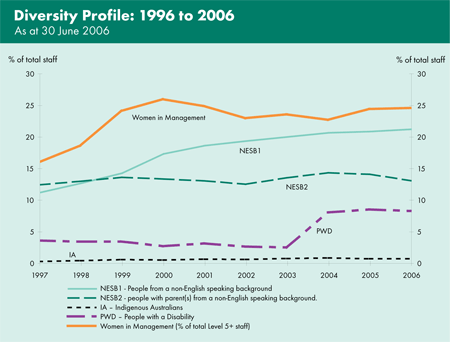
The percentage of Indigenous Australians at the RBA has remained stable for the past 10 years. On the other hand, the percentage of women in management and staff from a non-English speaking background (NESB1) or whose parents are from non-English speaking backgrounds, has increased. The percentage of people with disabilities has remained constant after a substantial increase that followed an update to staff records in 2004.
Age
The median age of RBA staff is 37 years and has changed little in the past few years. Comparatively, the ABS Labour Force Survey 2005 reveals that the median age for all occupations is 39 years. The percentage of RBA staff who are aged less than 35 years of age remains at 44 per cent. However, over the next ten years, 29 per cent of RBA staff will be eligible for retirement (aged 55).
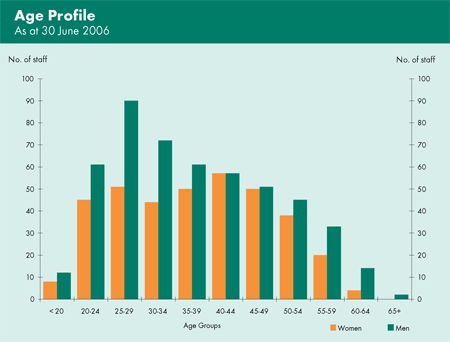
Tenure
The average tenure of RBA staff has increased to 12 years compared with 11 years for 2005. However, 57 per cent of staff still have less than 10 year's service, the same as last year and compared with 55 per cent in 2004 and 50 per cent in 2003. Similar to previous years, 20 per cent of staff have more than 20 years service and 57 per cent have more than five years service. There is a gender gap in favour of men in regard to length of service between the 16 to 20 year period of service, but the gap gradually closes with an increase in tenure beyond that period.
Graduate retention rates continue to be lower than for other new recruits but remain comparable to other financial institutions. Graduate retention rates will continue to be monitored with a view to identifying appropriate retention strategies especially in relation to women where retention is marginally lower than for men.
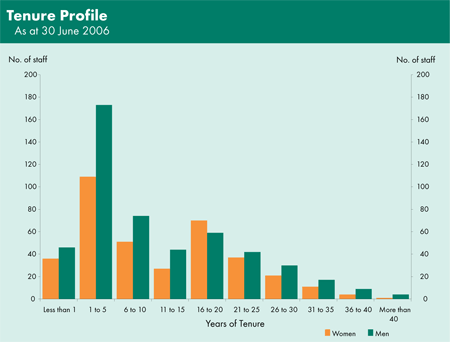
Section 3.2: Gender
Staff Numbers
The current number of staff for this reporting period is 865. As at 30 June 2006, women represented 42 per cent of total staff, the same as in 2005.
Occupational Groups
Gender representation in the various occupational groups continues to be monitored, as well as changes in occupational structure over time. The two main occupational groups are professional and clerical.
The percentage of women in clerical positions remains the same as in 2005, with 40 per cent of women employed in clerical roles compared to 13 per cent of men. There was a rise in women occupying professional positions to 42 per cent for this year (40 per cent in 2005).
Women in Management
Five per cent of women at the RBA are employed in management positions, a decrease of 1 per cent from 2005. This compares to 13 per cent of men currently in management positions which is unchanged from 2005. Twenty-three per cent of all RBA management positions are held by women, again a decrease of 1 per cent from 2005, reflecting the resignation of 3 women within this reporting period. However, the overall increase of women in management positions within the last ten years has risen by 8 per cent. The Bank continues to investigate strategies to increase the proportion of women in management positions.
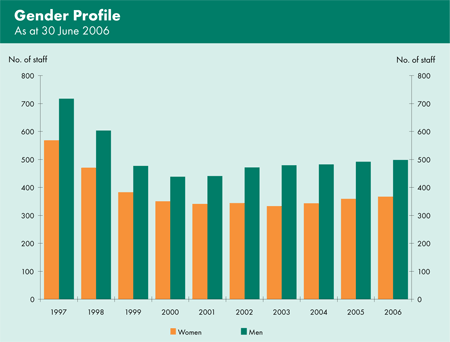
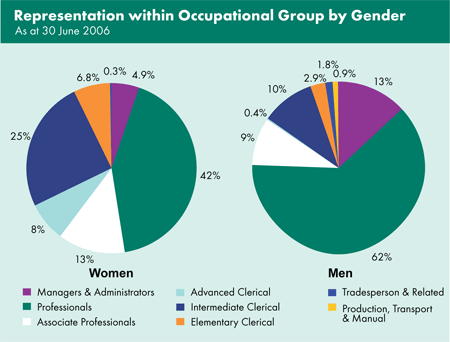
Transfers, Rotations and Secondments
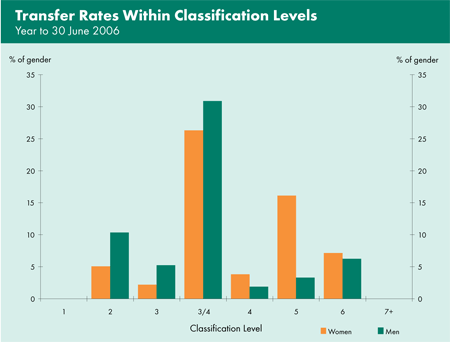
Transfers and rotations within the RBA, including to overseas and regional offices, are an important means of staff development. Transfers are permanent appointments to a position. The number of staff transfers within the RBA for 2005/06 was 51, a slight decrease on a year ago. Of these transfers, 40 per cent were women and 60 per cent were men. Level 3/4 continues to be the most significant grade group to benefit from transfers, accounting for 43 per cent of the total transfers recorded during the year. This group comprises graduate economists and analysts who have completed the Graduate Development Program.
Rotations are temporary movements of staff. The number of staff rotations decreased from 64 last year to 54 this year (excluding trainees and graduates). With the exception of 2005 and 2002, the number of rotations has been steadily declining over the past seven years. Women represented 51 per cent of rotations. The Level 3/4 grade grouping again accounted for a significant (22 per cent) number of total rotations within the RBA.
Secondments to other institutions are also available. Over the past year, staff have worked at the Bank for International Settlements, the UK Financial Services Authority, the Bank of France, the Australian Treasury, the Australian Taxation Office, the Australian Prudential Regulation Authority and the Australian Securities and Investments Commission.
Graduate Recruitment
Graduate Development Program
In the 2006 recruitment drive, 454 applications were received for the Graduate Development Program.
The number of applications received increased by 80 from 2005. There were 164 applications from women and 290 applications from men. The ratio of women to men was similar to the last reporting period and continues to reflect the gender ratio of honours level enrolments in economics at Australian universities, the key target group for the RBA. The ratio of women to men accepted on the graduate program was 34:66 for 2005/6.
| Year | Women | Men | Total | Ratio |
|---|---|---|---|---|
| 2006 | 11 | 21 | 32 | 34:66 |
| 2005 | 15 | 25 | 40 | 38:62 |
| 2004 | 8 | 21 | 29 | 28:72 |
| 2003 | 8 | 26 | 34 | 24:76 |
| 2002* | 14 | 25 | 39 | 36:64 |
| 2001 | 7 | 26 | 33 | 21:79 |
| 2000 | 14 | 20 | 34 | 41:59 |
| *The 2002 figures include 4 graduates that did not participate in the Graduate Development Program (2 male and 2 female) | ||||
Cadetship Award
A total of 162 applications (101 men and 61 women) were received for the 2005/06 cadetship award. Eighteen candidates accepted the Award, 14 men and 4 women. The gender ratio of 25:75 represents a decrease in female applicants by 18 per cent compared to 2005. There is also a reduction in the total of cadetships compared to last year.
Fourteen of the 18 cadets (11 men and 3 women) accepted offers to join the 2007 Graduate Development Program.
| Year | Women | Men | Total | Ratio |
|---|---|---|---|---|
| 2006 | 4 | 14 | 18 | 25:75 |
| 2005 | 9 | 12 | 21 | 43:57 |
| 2004 | 9 | 9 | 18 | 50:50 |
| 2003 | 7 | 10 | 17 | 41:59 |
| 2002 | 3 | 16 | 19 | 15:85 |
| 2001 | 8 | 10 | 18 | 44:56 |
| 2000 | 6 | 9 | 15 | 40:60 |
Individual Contracts
Individual common law employment contracts, providing flexibility in remuneration, are offered to most staff as an alternative to coverage under the RBA's collective agreement. As at 30 June 2006, 65 per cent of staff were on individual employment contracts, compared to 62 per cent in 2005 and 53 per cent in 2002. Fifty-two per cent of women were on individual contracts compared to 74 per cent of men. In 2005/06, women in the RBA earned on average 99 per cent of what men earned; this is currently above the national average of 84 per cent.
| Occupational Group | Women (%) | Men (%) | Total (%) |
|---|---|---|---|
| Managers | 95 | 97 | 96 |
| Professionals | 78 | 86 | 83 |
| Associate Professionals | 38 | 55 | 46 |
| Clerical | 23 | 20 | 22 |
| Total Staff on Individual Contracts | 52 | 74 | 65 |
Childcare Centre
This reporting year has seen a continuing focus on enhancing the RBA's commitment to working parents, particularly women returning to work from parental leave. The RBA's joint venture with Lend Lease Corporation Ltd, the Billabond Children's Centre, caters for a total of 66 children aged between 0 and 5 years; 20 of those places are reserved for the children of RBA staff members. There are currently 13 members of staff whose children use the Centre; these include 7 men and 6 women. Eleven of these staff members occupy professional or management positions. Salary sacrifice arrangements are available to RBA staff.

Parent Room
To complement the childcare centre, a Parent Room was first made available for use by staff last year. The room provides a private facility for women returning to work who would like to maintain breastfeeding. Staff on parental leave visiting the RBA that need a private space to breastfeed or change a nappy may also use the room. The room is well equipped and has been accredited by the Australian Breastfeeding Association.
Section 3.3: Work/Life Balance
Personal Leave
Personal Leave for caring purposes can be taken either on a half or full day basis. In 2005/06, it was used by 394 staff (46 per cent), a rise of 2 per cent from 2005. Of the staff who took the leave, 53 per cent were men, the same as last year. During the year, 50 per cent of women at the RBA used Personal Leave for caring purposes compared to 42 per cent of men.
Part-Time Work
During the year, 61 staff worked part-time (55 women, 6 men) compared to 64 (59 women, 5 men) in 2005. The figures reflect mostly women who were on temporary part-time work arrangements.
Parental Leave
Women are entitled to 14 weeks' paid maternity leave and men to two weeks' paid paternity leave. The chart below provides a breakdown based on gender for staff commencing paid parental leave.
During 2005/06, a total of 44 staff commenced paid parental leave (19 women and 25 men). There was a slight decrease of 1 per cent from 2005 but this was still higher than in 2004 when 36 staff commenced paid parental leave (16 women and 20 men).
For this reporting period, a total of 30 women returned from parental leave. Eleven of those returning resumed part-time while 13 resumed full-time work. This compares favorably with 14 women who returned in 2005 from parental leave of which 9 resumed part-time and two resumed full-time. An 80 per cent return rate was experienced in 2005/06 compared to 79 per cent for 2005. The percentage of women resigning prior to completing parental leave for this reporting period was 20 per cent, 1 per cent lower than for 2005.
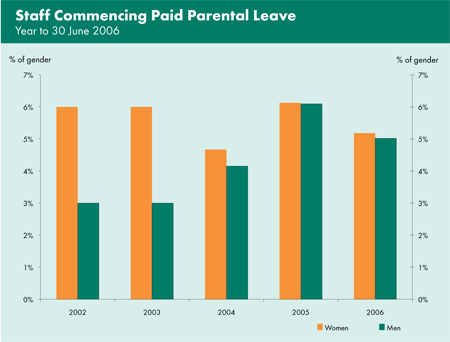
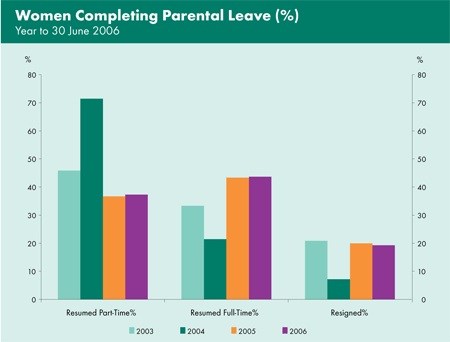
Fitness Facility
The RBA encourages a healthy lifestyle. In addition to supporting sporting events, the RBA operates a fitness facility at Head Office. The facility is available for use by staff at lunchtime and out of work hours. Staff desiring to use the facility must first attend a training session in the safe use of the equipment. Approximately 600 staff members received this training during 2005. During the year, 94 staff members attended weekly pilates and yoga classes.
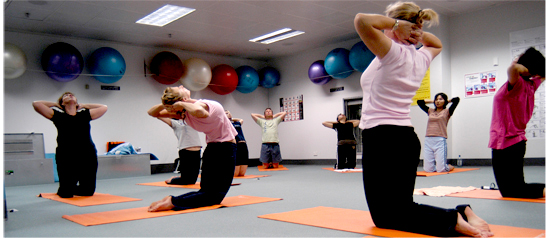
Section 3.4: Indigenous Australians
Staff who have identified as Indigenous Australians continue to account for a very small proportion of staff (0.6 per cent in 2006).
Business Administration Traineeship
At least one Business Administration Traineeship continues to be designated for an Indigenous Australian to encourage a higher representation at the RBA. The feasibility of utilising the Australian Government's National Indigenous Cadetship Project continues to be explored as an additional way of targeting Indigenous Australians for employment opportunities within the RBA.
NAIDOC Week
As one way of recognising Indigenous culture and promoting to staff NAIDOC (National and Aboriginal Islander Day Observance Committee) Week in July 2006, the RBA took the opportunity to highlight forthcoming events for NAIDOC by creating a banner on the intranet site to provide access to the NAIDOC website.
Section 3.5: Race-Ethnicity
Representation at RBA
The percentage of staff who identified themselves as NESB1 (staff who were born overseas and whose first language is not English) remained at 21 per cent for this reporting period. The NESB1 group are represented in the professional occupational category. There was an increase in the Associate Professional category to 10.4 per cent and similar to 2005, 2.7 per cent are currently employed in management positions.
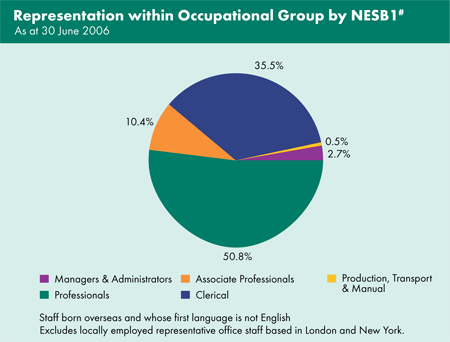
Business Writing Training
The RBA again offered training to staff in business writing to assist with career progression. A Technical Business Writing refresher course was offered this year which was aimed at building on last year's two-day Technical Business Writing skills program.
The Bank acknowledges the varying communication styles used by different cultures. Hence, a variety of business writing courses was offered to reflect the more technical nature and culture of the Bank. One such course was a Grammar Writing Skills Workshop, attended by 6 members of staff who had identified themselves as NESB1.
Harmony Day
For the week commencing 21 March 2006, the RBA supported and promoted Harmony Day. Staff were provided with information about the meaning of the day via the intranet, the staff magazine Currency, and staff newsletters. Harmony Day ribbons were also available for staff to wear and the staff café provided an array of international dishes throughout the week.

Section 3.6: People with Disabilities
Representation at RBA
The number of staff who have identified as having a disability remains at 8 per cent in 2006. The national figure for people with disability in the workplace is currently 17 per cent; 12 per cent of this national figure are employed by organisations who made special arrangements to accommodate people with disability in the workplace.
Disability Initiatives: Workplace Diversity Plan
2006–2008
The Bank's Workplace Diversity Plan 2006–2008 differs from previous plans, in that it incorporates initiatives previously embodied in a separate Disability Action Plan. Nevertheless, the initiatives continue to draw on the principles that underpin the Commonwealth Disability Strategy.
A review of the Commonwealth Disability Strategy was commenced in 2005. This government initiative is part of a ten year plan under which Commonwealth agencies develop Disability Action Plans in alignment with the Disability Discrimination Act 1992. At this time, a new Commonwealth strategy has not been developed. However, the Bank intends to review the disability initiatives in its plan once the strategy is released.
People with disabilities is one of the key diversity areas around which the new Workplace Diversity Plan 2006–2008 is built. The other areas are gender, work/life balance, Indigenous Australians, race-ethnicity and mature workforce. Two groups – the Disability Action Plan Consultative Group (DAPCG) and the Systems Accessibility Technical Group (SATG) – meet quarterly to monitor the implementation of the Plan in respect of disability initiatives and assistive technology. The Plan and the related initiatives are listed in Appendix 4.2.
Membership of Employer Disability Group
The RBA continues to be a member of a not-for-profit employer disability group ‘Employers Making a Difference’ (EMAD). The membership provides the RBA with a strategic business partner to assist in the development of disability initiatives as well as an additional resource for staff.
Awareness
Training & Development
The RBA sources suitably experienced external providers to assist with its annual disability awareness program. The Bank is currently working with ‘People with Disability’ to develop awareness programs for frontline customer service and facilities staff as a proposed area of focus in 2006/07. More information will be available in the next reporting period.
Mental Health Awareness workshops were also conducted with 25 staff attending a 1 hour awareness session and 35 managers/supervisors attending a 3 hour workshop. The Bank plans to extend the mental health awareness series to incorporate other health and wellbeing topics to be offered during lunchtime workshops during 2006/07.
Brochure: Supporting Staff with Disabilities
In 2006, the disability awareness brochure Supporting Staff with Disabilities was updated in keeping with the new Workplace Diversity Plan 2006–2008. The brochure was distributed to all staff and is available on the Bank's intranet site. All new starters will also receive the brochure as part of their induction.
International Day of People with a DisAbility
The RBA once again celebrated International Day of People with a DisAbility on 3 December. Information about the meaning of the day was provided via the intranet and the staff magazine Currency. Displays and information leaflets were also placed in the staff café.
Access
Work is continuing on a new data centre in basement level 2. This project is compliant with the Building Code of Australia and Disability Discrimination Act requirements and includes access ramps to the data centre and its ‘flight deck’. During the next reporting period an investigation of the feasibility of improving access to the lift lobby will be explored.
Assistive Technologies
Assistive technology is a general term for specialised hardware and software designed for use by people with disabilities who are normally unable to use standard PCs either permanently or for a period of time. The Bank is currently establishing a facility or ‘test lab’ to test systems for compatibility with assistive technology. The test lab will accommodate the more commonly used assistive technologies. This not only ensures compatibility of the Bank's systems with assistive technology but encourages RBA's own system developers to become familiar with assistive technology. To raise awareness of the test lab, staff have been surveyed about their knowledge of assistive technology and encouraged to identify whether they require the use of such technology.
The Bank has also introduced a new Computer Based Training course which offers a wide range of accessibility topics and again enables the Bank's own developers to expand their skills in catering for different levels of system accessibility.